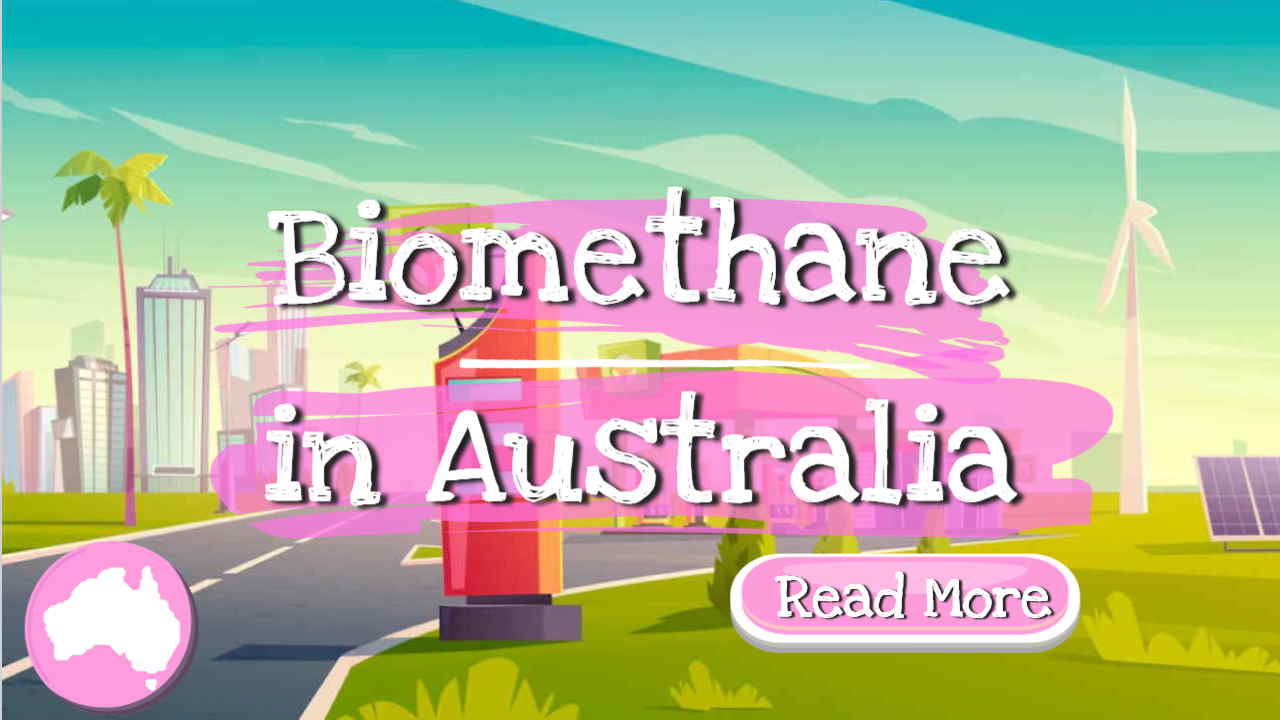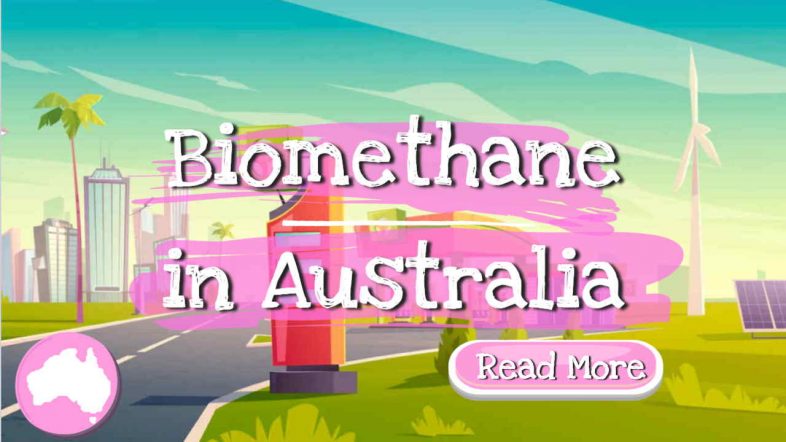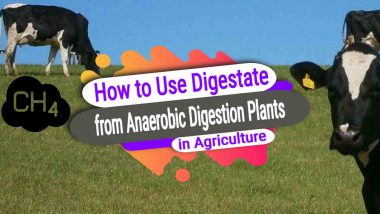Biomethane in Australia is getting started. The construction of Australia's first biomethane plant has begun as public and industrial demand for renewable natural gas and low-carbon transportation fuels rises. The country also has a new government that is willing to go above and beyond in many aspects of climate change mitigation.
The result is that things are looking good for the production of biogas which instead of being installed to generate electricity will be upgraded and fed into the natural gas pipeline networks from which it will replace the (excessively expensive) use of climate-change-inducing fossil-fuel-based natural gas.
Producing electricity from the biogas produced from the anaerobic digestion process is not in itself a bad thing, but injection into gas mains is:
- not only a more efficient way to deliver energy to customers,
- allowing transport fleet operators to take biomethane from the gas grids at their depot to fuel their truck fleets reducing the need for diesel fuel (DERV).
Diesel is not only a vastly dirtier fuel than methane (i.e. biomethane), given its emissions. It is also a fossil fuel in urgent need of being replaced if Net-Zero carbon emissions are to be achieved by 2050.
Biomethane trucks are readily available now. Australia will soon be making a lot of fuel for them if this news is correct.
But, if you are wondering how a gas-grid customer gets biomethane out of a “natural gas” main remember that biomethane and natural gas are essentially the same fuel. The biomethane user simply signs a contract with a verified biomethane supplier. The quantities fed in and used must of course be matched. It does not matter that the biomethane buyer may actually be using molecules of natural gas.
Now read on to find out just how the development of the sustainable energy source, biomethane in Australia, is starting:
On This Page:
- Australia’s First Biomethane-to-Gas Project Launched
- Biogas opportunities for Australia
- Top Biomethane and Bioenergy Producing Nations are Already Benefiting
- A Bioenergy Roadmap for Australia
- The Malabar Biomethane Project in More Detail
- Biomethane to Grow as Part of Global Renewable Energy Supply
- Renewable Gas (Biomethane) in Australia
- How Do Biomethane Projects Work?
- Australia’s first biomethane-to-gas network project underway
- Works Begin on Australian Gas Pipeline Injection Project
- Natural Gas No Longer the Way, Report Says
Sustainable Fuel Petrol station vector created by upklyak – www.freepik.com
Australia’s First Biomethane-to-Gas Project Launched
The Australian government and the state government of New South Wales (NSW) have announced the start of what is being billed as “Australia's first” biomethane-to-gas project. Wastewater from Sydney's Malabar Treatment Plant, Australia's largest, will be utilised to generate biomethane, which will be used to power thousands of homes and businesses across the state.
Biomethane is a refined form of raw anaerobic digestion biogas that can be used to replace natural gas.
The Australian Renewable Energy Agency (ARENA) has announced $5.9 million in financing for grid operator Jemena to test injecting biomethane into the natural gas network in New South Wales on behalf of the Australian government.
Thousands of organizations and enterprises in Australia have requested biomethane injection into gas distribution networks, prompting this shift toward biomethane.
The commonwealth government received an open letter. The letter urges for biogas to be recognised as a viable option for addressing energy market decarbonization concerns.
This is the first time that businesses from across the industry have urged the government to recognise biogas's potential. The letter, according to Shahana McKenzie, CEO of Bioenergy Australia, represents millions of employees from business, industry, and utilities who are prepared to collaborate to offer creative climate-change-reduction solutions.
Biogas Opportunities for Australia
The study will also look into the possibility of using Renewable Gas Trading to connect gas users with renewable gas production plants. Such trading methods would enable a highly reproducible ‘green gas' market to be established across various gas networks.
If successful, the project is likely to encourage the Australian waste industry to adopt biomethane technology, with the application having far-reaching implications beyond wastewater treatment.
According to Jemena, there are more than 30,000 Tjs of potential biogas near the NSW gas pipes, enough to power tens of thousands of households.
Top Biomethane and Bioenergy Producing Nations are Already Benefiting
Worldwide, the top biomethane producers include Germany, the United Kingdom, Denmark, Sweden, France, Italy, and the United States. The international market for biomethane equipment is also growing.
Early adopters of the technology stand to gain in exports and through job creation in this expanding industry, plus by reducing climate change they help reduce the future costs of higher global temperatures.
Global clean energy policies, such as the European Green Deal, will help create extra demand for biomethane. The largest opportunities lie in the Asia-Pacific region, where natural gas consumption and imports have grown rapidly in recent years.
Australia has so far been lagging behind the rest of the world on biomethane use.

A Bioenergy Roadmap for Australia
The Australian Renewable Energy Agency is working on a roadmap to determine bioenergy's position in the country.
Biogas is a type of bioenergy that is created mostly from household or agricultural waste and can be utilised to generate renewable energy as well as money for anaerobic digestion plant operators via renewable energy certificates.
Is it, however, truly possible to purify this biogas to a consistently high grade and incorporate it into gas networks to improve decarbonization opportunities?
Yes. It appears to be the case, and a rising number of countries are already taking steps in this direction.
According to the Bioenergy Taskforce of the International Energy Agency (IEA), there are over 14,000 biogas production projects worldwide, with Germany clearly leading the pack with over 10,000 projects.
Since 2017, nearly all new installations have been enhanced gas grid injection bioenergy energy facilities that produce biomethane.
Plant and animal by-products, agriculture, farming, forestry, and human wastes are all sources of bioenergy.
It offers a reliable and responsive carbon-neutral energy when upgraded into biomethane. In the United States and Europe, bioenergy and waste-to-energy projects are common.
In 2016, Bioenergy Australia projected that the US biofuels business contributed $459 billion to the economy, employing 4.65 million direct and indirect people. More than a million terajoules of biogas were produced globally in 2014, and output has increased significantly since then.
The Malabar Biomethane Project in More Detail
In Australia's first biomethane-to-gas network project, Jemena's $16 million Malabar biomethane project has started equipment work on its upgrader package.
Jemena has a number of renewable gas projects, including the Malabar biomethane plant. The renovation is being carried out in collaboration with Sydney Water and with the assistance of the Australian Renewable Energy Agency.
The upgrader equipment is made by Eneraque, a Brisbane-based company.
Water, carbon dioxide, other gases, and pollutants are removed from wastewater by biomethane upgraders, which generate sustainable biomethane that may subsequently be put into the gas network.
Eneraque, an Australian-owned and operated renewable energy infrastructure and equipment company, has partnered with Bright Biomethane.
For energy firm Jemena, Bright will construct its first biogas upgrader in Australia at the Sydney Malabar wastewater treatment complex.
Biomethane will be refined from biogas from Sydney Water's Anaerobic Digestion Plant and distributed through the grid. The Malabar biomethane project, which is billed as Australia's first biomethane gas grid injection project, is set to be finished in 2022.
The utilisation of biogas has a slew of environmental and economic advantages. The method entails converting biogas (1,100 nm3/hour) produced by the Malabar WWTP's current anaerobic digestion equipment to biomethane.
Biomethane is a renewable pipeline-compatible gas that is almost entirely made up of methane. The biomethane is then injected into the Jemena gas network, where it will be used for cooking, heating, and hot water in thousands of Sydney homes.
Biomethane to Grow as Part of Global Renewable Energy Supply
Biomethane remains a small portion of the global renewable energy puzzle. But it is quickly spreading across the globe in conjunction with the bioenergy and waste to energy sectors generally expanding. Biogas is only 1. 5% of the global renewable energy supply. But on an Australia-wide basis, it is estimated that the biofuels industry more broadly could provide 250,000 jobs and avoid 9 million tonnes in carbon emissions.
European Biogas Association (EBA), Gas Infrastructure Europe (GIE), the Natural & Bio Gas Vehicle Association (NGVA Europe), and SEA-LNG published a joint paper that highlights the true potential for BioLNG to decarbonize heavy-duty transport and shipping in a fast and cost-effective way.
The report predicts the EU production of BioLNG is set to increase tenfold by 2030 which will play an important role in transport decarbonization. Additionally, the gas fueling infrastructure is expanding fast and recorded 4000 CNG and 400 LNG stations in place per NGVA Europe.
Climate change is evident, and all of the Australian industry's previous high carbon emissions practice requires urgent transformation. The energy and chemical sector touches almost every person on earth each day.
Whether it’s heating homes or powering devices, the provision of energy is essential to our daily lives. We all need to align and join forces in order to transition to a net-zero carbon pathway that supports the United Nation's goals to reduce carbon emissions by 45% by 2030.
The molecules of CH4 (methane) should take center stage in the discussion around climate change.
Biomethane is often overlooked as a viable transport fuel option, yet when produced from wastes can provide a highly competitive, low-cost transport fuel alternative.
Biomethane upgraded for use in vehicles can be produced for USD 0. 45–0. 55/lge from wastes, and USD 0. 65–0. 75/lge when maize silage is added. Large-scale production requires the purchase of feedstocks from surrounding farms (e. g. Maize silage) for much of the throughput and is thus more expensive.
Renewable Gas (Biomethane) in Australia
Biogas is a local, renewable, and dependable energy source. The biogas sector provides a waste treatment alternative while also contributing to the growth of local economies.
Bioenergy Australia commissioned ENEA consulting to write this public paper, which looks at the benefits of biogas and the challenges the industry is now facing in Australia. The paper also contains suggestions for growing Australia's biogas industry. The Australian Renewable Energy Agency, the Clean Energy Finance Corporation, Energy Networks Australia, and the International Energy Agency's Bioenergy Task 37 all contributed to the publication of their paper.
ARENA stated in April 2020 that it was seeking input from stakeholders in Australia's bioenergy sector to support the development of the Bioenergy Roadmap, which would assist inform the next round of investment and policy decisions in the sector.
Angus Taylor, the minister for energy and emissions reduction, emphasised the construction of a biomethane Emissions Reduction Fund (ERF) in late 2020 to aid the bioenergy roadmap.
Biomethane is a gas that is created from biological matter and is interchangeable with natural gas (waste and agricultural residues). There is a potential national resource of 371pj per year that is currently being underutilised. As far as we can tell, this equates to 80 percent of the east coast domestic gas demand for renewable gas.
Under the emissions ERF, the Emissions Reduction Assurance Committee is requesting feedback on a proposed biomethane method package. The ERF encourages Australian firms to reduce greenhouse gas emissions and engage in carbon-storage efforts.
How Do Biomethane Projects Work?
Biogas from organic waste is captured and converted into biomethane in a biomethane project. After that, the biomethane is burned as a natural gas alternative or used as a feedstock in industrial processes. Biomethane activities are to be introduced to three Australian ERF waste treatment methods in this method bundle.
Sludge management in the wastewater treatment industry is an economic and environmental concern, and biogas recovery is a means to add value to operations.
It entails digesting sludge to reduce its volume and producing biogas, which can be used to generate renewable energy. The energy can be used directly onsite in electricity and heat forms via a combined heat and power (CHP) process, or the biogas can be cleaned to produce biomethane, which can then be fed into the gas network, if accessible, depending on the local regulations and incentives.
The biomethane will be produced at the Malabar Waste Treatment Plant in South Sydney and pumped into Jemena's current gas distribution network, which will power around 6300 houses in Sydney.
Prime Minister Scott Morrison wants a “gas-led recovery” from the coronavirus recession, and as part of that plan, he plans to open up new gas supplies and support the development of a gas-fired power plant.
The federal government sees gas as the most cost-effective method to move away from coal, while the NSW government is focusing on batteries and pumped hydro to supplement weather-dependent renewables.
Australia’s first biomethane-to-gas network project underway
Most people don't like to think about what happens to the trash they flush or what it could be used for, but Jemena is on pace to upgrade wastewater for a great purpose, with the development of critical equipment for its Malabar biomethane project, currently underway.
Eneraque PTY Ltd, based in Brisbane, is building the upgrader package for Australia's first biomethane-to-gas network project. Water, carbon dioxide, other gases, and pollutants are removed from wastewater by the anaerobic digestion process which makes biogas. The biogas is then purified to natural gas quality in biomethane upgraders, which create sustainable biomethane that may subsequently be put by injection into the gas network.
Works Begin on Australian Gas Pipeline Injection Project
As huge gas networks strive to prepare for clean fuels, we've all heard about hydrogen blending. Instead, we're hearing about blending biomethane.
DeLorean Corporation (ASX: del), an ASX-listed biomass to energy firm, is working on a Memorandum of Understanding (MOU) with pipeline operator Australian Gas Infrastructure Group (AGIG).
The businesses will “work toward building a mutually acceptable business model to develop, construct, own, and operate anaerobic digestion plants to feed biomethane into AGIG networks,” Delorean said in a statement to the ASX yesterday.
Natural Gas No Longer the Way, Report Says
While Australia's greenhouse gas emissions reduction report card isn't exactly sparkling, there are plenty of opportunities to get back on track during this moment of fast transformation in the energy sector. Increased usage of renewable electricity sources such as wind and solar is helping to reduce emissions, and gas can also help.
Natural gas accounts for almost a quarter of Australia's total energy consumption.
Biomethane production potential in Australia has been investigated, and a recent analysis found that biomethane is a realistic, underutilized solution for decarbonizing Australasian natural gas networks.
New Zealand offers similar chances. By 2050, the predicted potential might replace approximately 20% of New Zealand's total natural gas consumption.
According to the study, upgrading biogas to biomethane might prevent 4% of New Zealand's energy-related emissions. This might be made from current and readily available organic waste, such as food waste from homes or farm waste, such as manure from cow sheds all throughout New Zealand.




